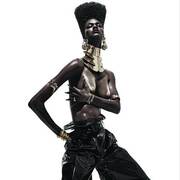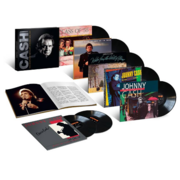New York, NY (Top40 Charts) Icelandic cellist, singer, and composer Gyda Valtysdottir, a founder of the band múm and 2019 winner of the prestigious Nordic Council
Music Prize, releases Epicycle II on her label DiaMond in collaboration with Sono Luminus on August 28, 2020.
Today, FLAUNT Magazine has the exclusive premiere of the video for the first single, Evol Lamina by Jónsi (Sigur Rós) and Gyda. The single will be released on Friday, July 3 on all digital services.
Epicycle II, which was produced by Gyda and mixed with Jónsi, features music written for her, and/or in collaboration with her, by eight of Iceland´s most compelling composers - Ólöf Arnalds, Daníel Bjarnason, Úlfur Hansson, Jónsi, María Huld Markan Sigfúsdóttir,
Kjartan Sveinsson, Skúli Sverrisson, and Anna Thorvaldsdóttir. The album is a sequel to her highly acclaimed first solo album from 2017, Epicycle, on which Gyda created personal renditions of written music spanning over 2000 years. An epicycle refers to the geometric model of the solar system by the Ancient Greek mathematician and astronomer Ptolemy, in which a smaller circle's center moves around the circumference of a larger circle.
On Epicycle II, Gyda stretches the boundaries of genre even further, selecting composers who all have created their own unique sonic environments. The outcome is an expansive and colorful landscape, varied but connected in profound unity through Gyda's highly personal touch.
A founding member of the experimental and groundbreaking band múm as a teenager in the late 1990s, Gyda later studied classical cello and improvisation in Reykjavik, St. Petersburg, and Basel. Known for her deeply personal and organic performances, she has worked with a varied group of artists across genres, performed concerts around the world, and composed music for films. She earned a double master's degree from the Hochschule für Musik in Basel where her main teachers were cellist and composer
Thomas Demenga and violist, composer, and improviser Walter Fähndrich.
Of the new album, Gyda says, "When the idea of Epicycle II came to me, it felt like it already existed. On the first Epicycle, I interpreted music by composers from the past. This time I wanted to collaborate with contemporary composers and musicians who have each created their own, unique musical language that doesn't fall easily into any existing category. It became clear to me that I didn't have to look far to find exquisite musicians all around me and soon I had a list of people who I greatly admire - people who had all shaped me in some way as a musician. I also happened to know all of them since I started making music in my teens. Our world is interconnected and I wouldn't be who I am without my relation to others, including the people that contributed to this record. This group of people is really a musical galaxy, where the connections are endless: From
Kjartan producing Ólöf's first record, which Daníel made some string arrangements for, to Úlfur touring as a bass player for Jónsi's solo tour and María's long collaboration with Jónsi and
Kjartan ... or from Daníel conducting Anna's compositions, as well as joining Sigur Rós for their orchestra concerts, to
Kjartan and Skúli soon releasing a duo album, and much more."
Gyda Valtysdottir writes of her connection to the composers and about each track on the album:
I met Skúli Sverrisson when múm was being born. I was absolutely honored that such an amazing musician would show our young band such respect and interest, being this cool cat from the New York jazz and new music scene. In 2002 he made an album called Napoli 23, with a group of musicians including the violist Eyvind Kang. That album and Eyvind's playing had a huge influence on me and I was so honored when they asked me to play with them on the release show. It changed my life. Since then, on the rare occasion I get to play his music, it is always a profound experience. The music is so clear, like a crystal, and when you perform it, it feels like dancing in the prism of its light.
Ólöf Arnalds was the coolest girl in the string camps I went to when I was eleven. She was thirteen and didn't see me. When we met again in college, I was blessed to become close friends with her. We were in the same circle of friends but we also had our own private hangouts, studying for music history exams, getting drunk on madrigals and motets and sharing new found musical crushes. She has a brilliant mind, her songwriting is timeless and when she serenades she seems to have access to places we don't all dare to tread. Ólöf's songs have always moved me deeply and it is a privilege to have her hand Safe to Love over to me for interpretation. It is such a perfect song on this constellation of works because it speaks about the space music offers love and allows it to flow - "we belong there - it is safe to love there."
Anna Thorvaldsdóttir and I both studied the cello with Gunnar Kvaran. She was a headstrong magical being, almost out of this world. She was already composing alongside her cello studies and I was lucky enough to perform some of her earliest works. It has been beautiful to watch her grow as a composer and expand her craft, and to witness the well-deserved recognition she has gained internationally. It is so rare, that combination of an incredibly hard-working glacial force with that amount of sensitivity and delicacy.
At quite a young age I was lucky enough to be able to make a magical loft my home in Reykjavík. It was right above a luthier's home and workshop. This luthier, Hans Jóhansson, later created the cello I now play. His twelve-year-old son Úlfur Hansson would practice death metal in the basement. As Úlfur grew older our age gap shrank to nothing. Later he studied composition and now we are close friends and frequent collaborators. His writing is so unique, an undiscovered planet. We frequently contribute to each other's music, but aside from that we have a shared space, unique to both of us, which we find through improvisation. It's like two chemical compounds combined to make up a totally new element. The piece is largely based on our dive into that space, which emerges from Úlfur's pre-written alien orchestral chords.
I met
Kjartan Sveinsson in early múm days, when Gunnar Tynes (half of múm) and I opened a few shows for Sigur Rós when they toured Iceland in 1999. We both dropped out of our bands and he has quietly been writing his own sublime music. He once told me about a dream he had, where we were composers in residency at a 12th century monastery in Iceland. I think that is the first time I thought about collaborating with him. Sometimes I feel that is where we know each other from before, as monks in a past live. We finally made it happen, not in a cloister but at the Funkhaus during the People Festival in Berlin 2019. The outcome of that collaboration was Liquidity, a piece we performed for the first time at that festival. This new collaboration also resulted in a short tour where we performed new collaborative work as well as each other's music.
Air to Breath by Daníel Bjarnason is the only work on the album that has been released before, but I knew right away how much I wanted to include it on the record. It is one of those composition I feel I can totally merge with - the closest thing to describing how I feel when I breathe in the moment. It has beauty and depth which Daníel holds with such grace and ease, a purity which made me fall in love with him, even if we were perhaps not the perfect match at the time. We were partners during the years that shape you the most; learning, sharing, arguing and influencing one another, and then departing after six years to become almost strangers again.
Evol Lamina was shaped and woven by Jónsi, out of vocal- and cello-improvisations that I did in his home in LA. It's energy that dances on the edges, flirting with boundaries. It's also a sound that shapes the gap between the skin of two persons. Jónsi was the last one on board in this project, but somehow he became the captain of the ship, co-producing Ólöf´s track and then finalizing all the mixes with me. I've known him since I was sixteen. We are distant planets that yoyo in and out of each other's faraway galaxies in circles of eons.
María Huld Markan was finishing her violin studies at the conservatory when I entered the school. I watched her move from the classical world to work with Sigur Rós and her band Amiina for years. Later she studied composition and now she masterfully combines her craftsmanship and creativity together. She shares with me the vision that music does not need to be divided into categories, so it has been fun to collaborate with her in the past; from playing in a symphony orchestra to film scoring, singing in a choir or making up arrangements for all kinds of music. The piece Octo was an open idea, a loop to play with which I immediately felt should morph with the heights.
























